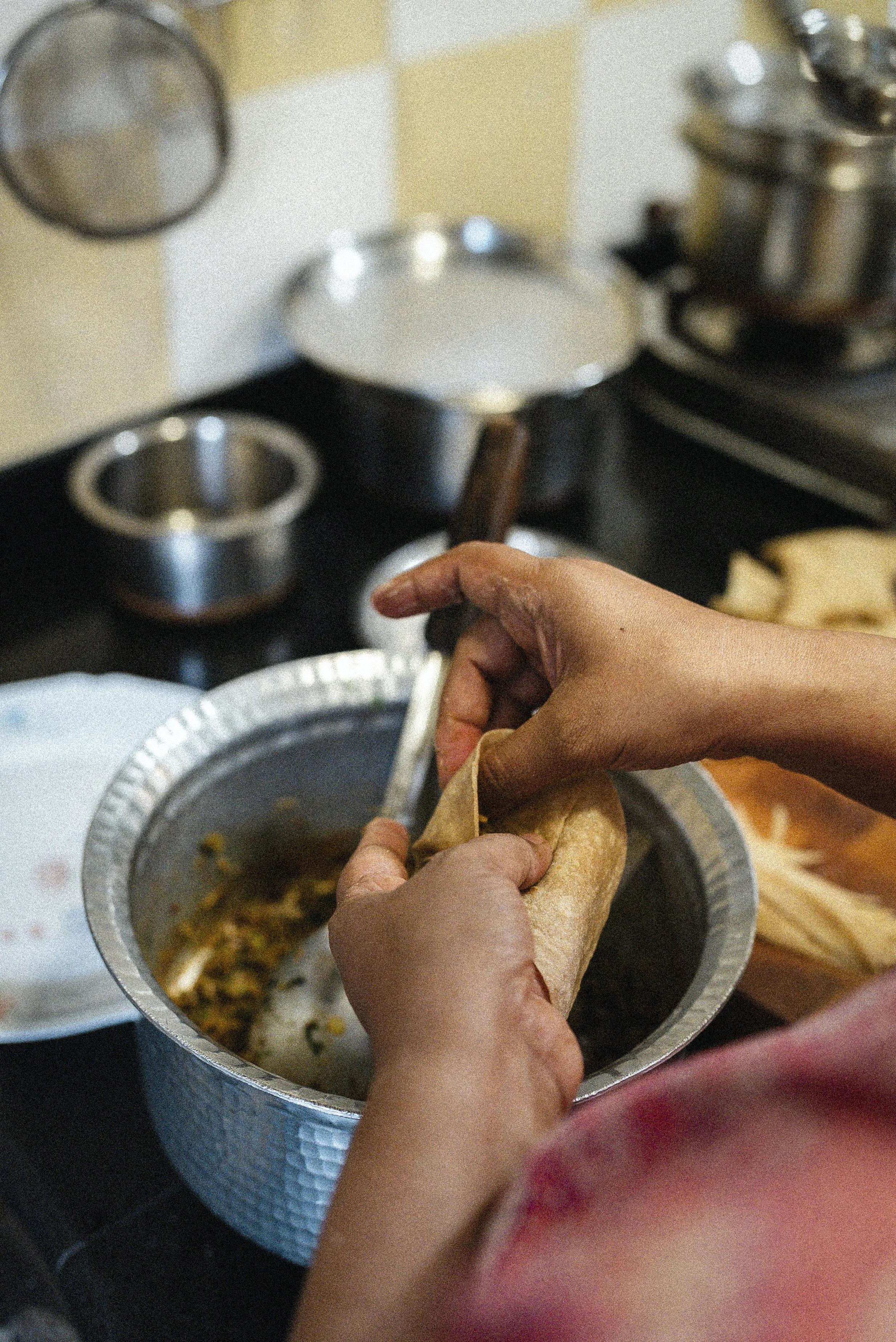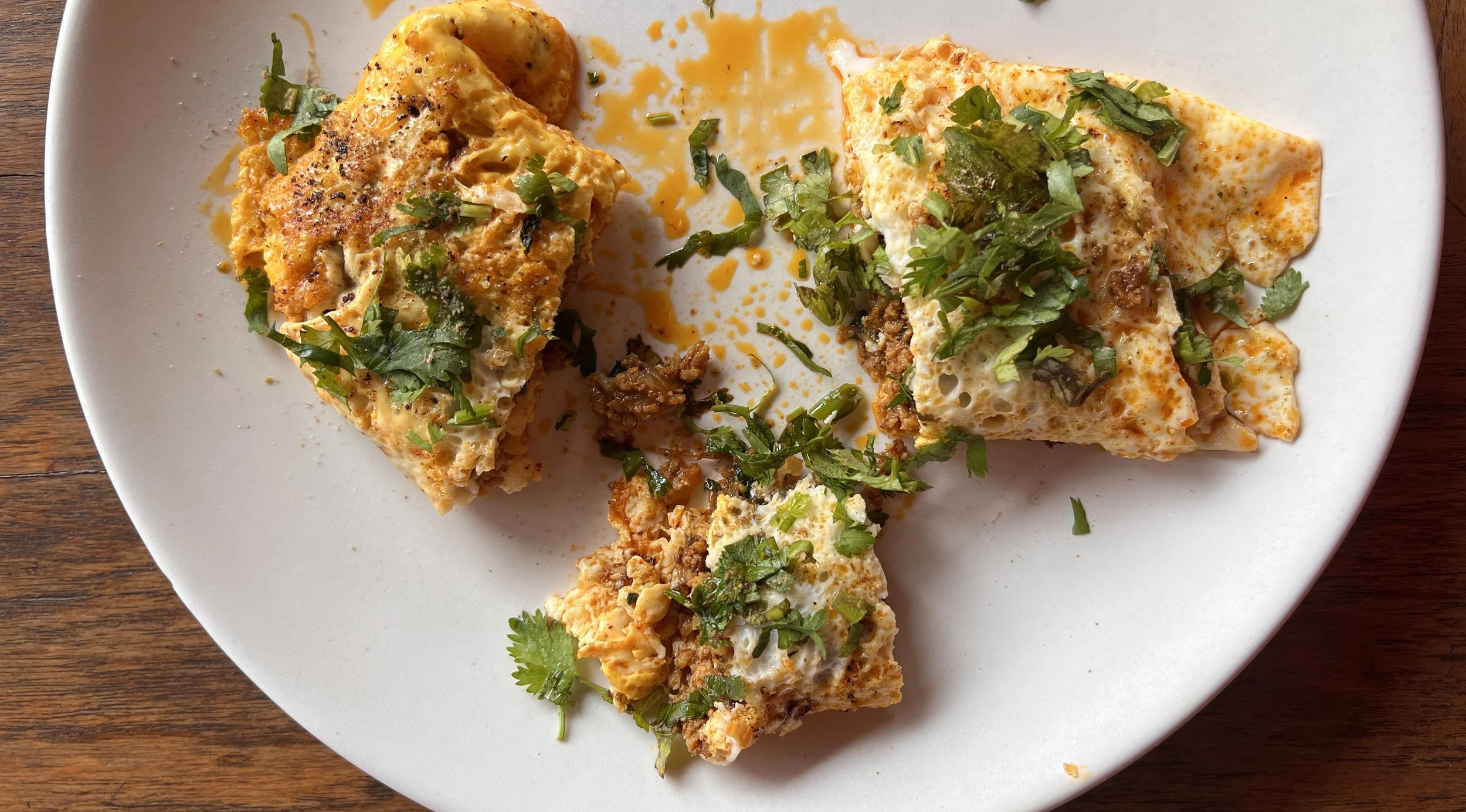#1000Kitchens: Zainab Tambawalla’s Kheema Samosas Keep a Bohri Legacy Alive

At Goya, celebrating home cooks and recipes have always been at the heart of our work. Through our series, #1000Kitchens, we document recipes from kitchens across the country, building a living library of heirloom recipes that have been in the family for 3 generations or more. In this edition, Anisha Oommen talks to Zainab Tambawalla about the Bohri community’s love for kheema samosas, a beloved dish prepared during Ramzan.
This season’s stories are produced in partnership with the Samagata Foundation—a non-profit that champions meaningful projects.
Zainab Tambawalla’s living room is a love letter to the city and Bohri history. There are smuggled street signs from the roads she used to live on in Bhendi bazaar, vintage adverts for Parle G and Rogers raspberry soda. The light comes in from the little balcony extension that is crammed with plants, in a way that only Bombay balconies manage in their mix of tropical exuberance and unreasonable realty. Shadows dance on the carpet underfoot.
Outside her window is a tree; birdsong fills the kitchen. Zainab has three pots on the stove, and moves between them, and a salad she is piecing together on the counter, with more speed and focus than we can keep up with. She shifts from one dish to the other, checking flavours, temperature, texture, tasting, adjusting, without missing a beat. She’s rolling ‘parr’ then picking it off the griddle, and tossing it mid-air with the deftness of a roomali master. The two halves come apart effortlessly, into delicate muslin rotis.
Zainab is an artist and animator, known most widely for the urban sketches of Mumbai’s disappearing heritage facades. Her works show the city’s sandwich makers, paani puri vendors, markets, shoe-shines, bringing tenderness to the ordinary, elevating them into extraordinary markers of city life, pausing to breathe stillness into a city that never has the luxury of pause.
As we enter, her son Ahmed is sitting at the dining table across from a Hindi teacher. His expression says everything, and we share a sympathetic nod. Hindi tuition is a universal suffering that binds across generations and regions. Zainab emerges from her room, and her energy fills the room in the way it does in every room she enters. Zainab is an artist whose work we know intimately; she illustrated Goya’s first cookbook A Kitchen of One’s Own. She brings high excitement, and a uniquely can-do, no-nonsense, say-it-like-it-is energy that we have come to associate with the city. But it is her curiosity and her sharp eye that ultimately is the greatest gift — as she transforms the everyday into a celebration of life.
Credit: Kajol Deorukhkar
She pulls an aluminum pot from the drawer, and empties a bowl of kheema into it. “This colander came from Karachi, and its perfect for washing kheema because the holes are so tiny.” In the pot, she has 250 gram of hand-cut mince. “Only hand cut, because texture is everything.”
She sets it on the stove, and sets out chopping onions. “You want the onions to cook down to a point that they lose their bite and turn sweet,” she explains as she tosses in two pinches of pink salt, a few spices, and her dhania-jeera mix – a steadfast presence in every Bohri kitchen.
The kheema samosas she is preparing today were a favourite at Iftaaris during Ramzan, and on the Eid table. “Now of course, my Iftaari is a single date,” she laughs. These samosas are slowly becoming less ubiquitous at weddings and festive celebrations; people are looking for exciting new options, and it doesn’t help that the kheema samosa is incredibly labour intensive. “You can spot a homemade kheema samosa a mile away. The crunch from the whole-wheat casing of a homemade samosas is unmistakable.”
She pulls out a wood-end chopping board she made herself at a woodwork studio. We giggle because this is very much on brand for Zainab. Between her meticulous kneading, rolling and stacking, she lifts the lid off the pot to peek at the kheema bubbling as the moisture leaves the meat. “I keep the lid on; you want it to catch at the bottom because that’s when you know all the moisture has gone.” A spiced umami aroma fills the room for a brief second, before disappearing into the cool morning air. It is enough to transport us to every incredible samosa we have ever eaten — at iftaaris, from childhood Ramzans at friends’ homes, and Mosque Road stalls with baskets on the back of bicycles overflowing with samosas. “You want all those bits that catch, because that’s where all the good flavours are.”
Kheema samosas, while a fairly prosaic dish, are steeped in technical skill and knowledge that fewer households are proficient in, because fewer people make it at home. Even the making of ‘parr,’ a technique specifically designed to roll out dough sheets thinner than a single ball roll-out will allow, watching for a puff up, and then delicate, deftly tossing while it is still hot, to allow the layers to come apart in a puff of steam.
“Much of this is done by feel,” Zainab demonstrates, tasting the kheema. “The trick is in the onions. You’ve got to let it cook down till it is almost sweet.” She massages the chillies between her fingers in a quick move, and then slits them down the middle, tapping out the seeds before chopping them fine. “You want the flavour of green chillies, but none of the pungency.”
“Being in the kitchen as a daily practice teaches you the science of cooking. Nothing has taught me more than this daily practice.” Zainab cooks everyday for herself and the family. “The problem with having eaten well in your childhood is that nothing less will do,” she laughs.
She turns off the flame, and adds a handful of finely chopped coriander and tender mint leaves into the pot, then puts the lid back on. When she reopens it, the herbs have wilted and the aroma has changed. There is a fresh topnote to the meaty umami of meat and onions. She tastes, then sets it aside in one fluid motion. “Excellent,” she announces.
But we are only halfway through. Now comes a deft folding and pleating, filling and sealing of dough pockets stuffed with kheema before she drops them into hot oil to deep fry. She is full of instructions that are hard won through experience.
“Use the undercooked side of the parr on the outside of the samosas.”
“Remember, start on medium flame and then turn it down, because otherwise the casing comes apart.”
We sit down to eat a thaal laid on the safra. Kheema samosas with homemade tomato salsa for dipping; bajra rotis with slow fried potatoes, dal samosa, and mutton floss. We begin with salt. The bajra rotis are delicate and sweet, from the sweetness of jaggery and a bite of sesame. Ahmed has finished Hindi tuition, and comes to join us, quickly pulling on a head covering before diving into the hot samosas.
ZAINAB TAMBAWALLA’S RECIPE FOR KHEEMA SAMOSAS
Ingredients
For the kheema filling:
250 g hand cut kheema
3 tsp ginger garlic paste
Pink salt, a generous pinch
3 tsp red chilli powder
3 green chilli, deseeded and chopped fine
1 tsp haldi
2 tsp dhana-jeera
5 finely chopped onions
A handful of tender coriander leaves, chopped
A handful of mint leaves, chopped
For samosa dough:
200 g whole wheat
Salt, to taste
Water, as needed
Oil, to knead
Method
To the kheema, add in the ginger garlic paste, salt, dry masalas and cook on medium flame until completely dry and the kheema starts to stick to the bottom of the pan slightly.
Now add in the chopped onions and allow to cook on a slow flame until the onions soften. The onions should soften completely and not have a bite or a crunch to them at all.
Turn off the flame, add the chopped coriander, mint and green chillies and mix well.
Keep covered and let the moisture help deglaze the pan.
Cool completely and then roll the samosas
For the samosa:
Knead the ingredients to form a smooth dough.
Allow to rest for 20 minutes.
Portion the dough into small 3-inch diameter balls, spread oil and dust with flour, and roll into thick rounds, placed in stacks of 2.
Grease the 3 inch roundels with oil and then dust with flour. This will allow the layers to separate easily without a tear in the next step.
Place each stack on a platform, and roll out into a single large, thin flat bread.
Place this thin roti onto a hot tawa or griddle, and allow to cook.
As soon as it starts to blister, and puff up with steam, remove from the tawa and toss delicately into the air with both hands. Warning: do this step with caution as the roti will be very hot. The roti will separate into two flatbreads, one side cooked and the inner side slightly undercooked.
Stack the rotis to make a pile with cooked side facing down, and slice them lengthwise along the diameter to form three strips per round.
Use each strip to hold the kheema filling (refer the video), with cooked side holding the kheema, and uncooked side on the outside.
Made folds as per video directions, and fry in hot oil.
Seal the samosas with a thin slurry of whole wheat atta and water.
Best paired with ketchup and eaten hot.
Words by Anisha Oommen. Images by Nachiket Pimprikar. Illustration by Kajol Deorukhkar.
Special thanks to our partners.
ALSO ON GOYA





















